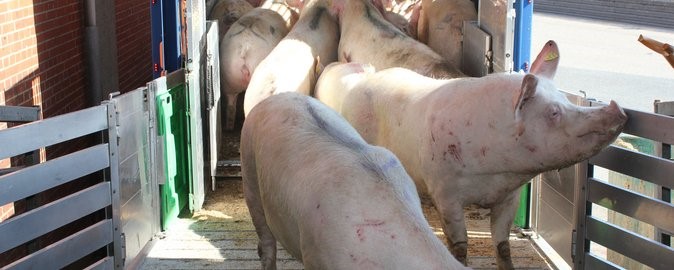Danish study identifies risk factors connected to the deterioration of the sows’ condition during transport to slaughter.
April 9, 2019

New research from the Aarhus University department of animal science in Denmark shows that transport of cull sows to the slaughter plant in many cases involves a deterioration of the sows’ physical condition compared to before they were loaded on the truck.
According to the university, the results may play a part in improving animal welfare during transport and contribute to the debate about the concept of fitness for transport of sows.
The Aarhus researchers said regarding transport, cull sows may be more vulnerable than other swine categories due to disorders or weaknesses after several reproductive cycles.
“We know very little about how the transport to the slaughter plant affects cull sows. Previous studies have focused on finishers," said senior researcher Karen Thodberg, who ran the study.
As the first study of its kind, the Aarhus researchers have completed a study of sows’ clinical condition before and after transport to the slaughter plant under commercial conditions in Denmark.
The large observational study included 522 sows from 12 Danish herds. The sows were part of 47 loads of sows transported for up to eight hours, depending on the distance from the herd of origin to the slaughter plant, the researchers said.
Standardized clinical examinations of all sows were carried out in the herd and at arrival to the slaughter plant. The examinations included body temperature, respiration rate, body condition score, gait score and various injuries, the university said. In addition, data on duration of transport, number and duration of stationary breaks during transport (sows were not unloaded) and temperature in the truck during transport were collected.
According to the announcement, on average, the sows were fifth parity (varying from parities 1 to 11), and nearly 40% of the sows were weaned on the same morning and were still lactating on the day of transport. The sows were transported an average of 179 km, varying from 78 to 280 km. The journeys lasted from 46 minutes to almost eight hours.
The average temperature on the truck during driving was 14.1°C but varied between 3.4 and 26.1°C. The highest temperature measured in the trucks was 29.1°C, the researchers said.
Deterioration during transport
Based on existing legislation in Denmark and the European Union, all sows were fit for transport before being transported, and 0.6% (three sows) arrived at the slaughter plant in a condition that would have been assessed as unfit for transport. Furthermore, the results showed that for several of the clinical measures examined before and after the journeys, a significant deterioration had happened in, for example, the number of superficial skin lesions and wounds, gait score and signs of dehydration, the researchers said.
Europe's regulation for transport of animals states that “all animals shall be transported in conditions guaranteed not to cause them in jury or unnecessary suffering” (Transport Regulation, EU 1/2005). However, the regulation does not specify limits for “injury,” which makes it difficult to determine whether or not the deterioration of the condition of the sows in this study was inconsistent with EU’s regulations for animal transport, Aarhus said.
“Our results highlight the need for more knowledge about the concept of fitness for transport and for further studies of the importance of transport for the welfare of cull sows, including development of methods that can optimize transport of pigs,” senior researcher Mette S. Herskin said.
According to Aarhus, the researchers identified a number of risk factors connected to the deterioration of the sows’ condition: temperature and duration (often in combination) as well as duration of stationary breaks in the journey and the waiting time before unloading.
“Our results are important knowledge in relation to welfare of this group of animals during transport, and they also stress the need for the continuous focus on welfare challenges as regards transport of cull sows. Therefore, future studies should continue working on improving how to identify and separate risk factors and in that way develop procedures enabling transport of cull sows to the slaughter plant without risking their welfare,” Thodberg concluded.
The full scientific article is "Transportation of Cull Sows — Deterioration of Clinical Condition From Departure & Until Arrival at the Slaughter Plant," published in Frontiers in Veterinary Science.
Source: Aarhus University, which is solely responsible for the information provided and is wholly owned by the source. Informa Business Media and all its subsidiaries are not responsible for any of the content contained in this information asset.
You May Also Like



